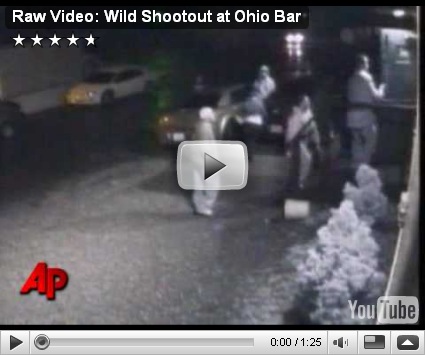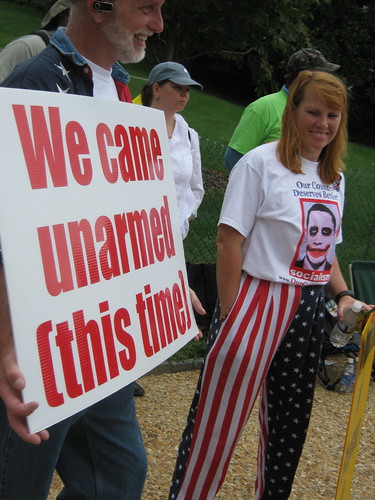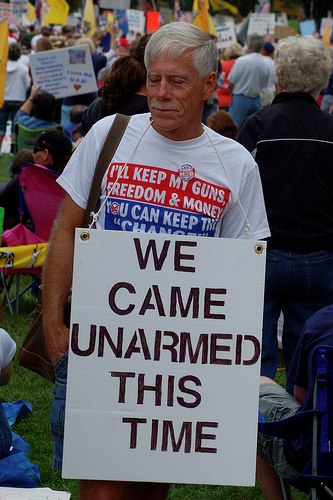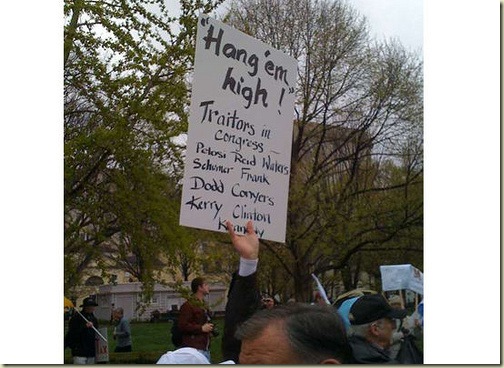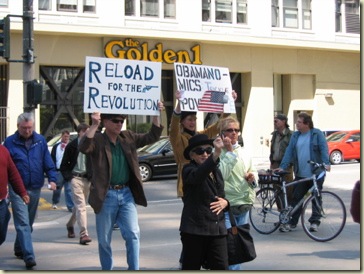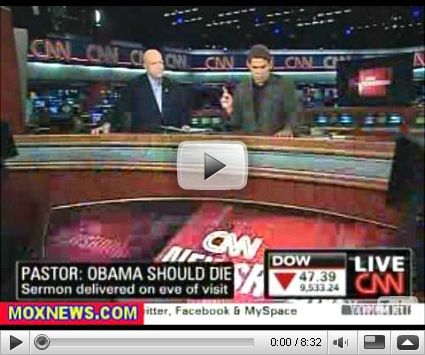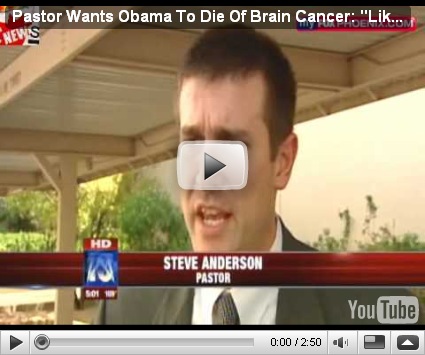I like National Public Radio (NPR). I really do. NPR’s programs Morning Edition and All Things Considered are my primary news source and I look forward to sitting in my car and listening to NPR news. However, I’ve long felt that NPR’s reporting was unfairly biased against Israel. For example, in January of this year, I criticized NPR’s reporting of the fighting in Gaza. NPR is not alone in anti-Israel bias, but a news organization with the reputation that NPR has should not be so obviously biased. And a report on yesterday’s edition of All Things Considered was so biased that I had to comment.
The report in question was presented by NPR’s new (as of June 2009) Jerusalem bureau chief, Lourdes Garcia-Navarro. NPR’s site has both the audio and transcript of the story. For convenience (and in case the transcript is later removed), here is the full text of the story:
MELISSA BLOCK, host:
You're listening to ALL THINGS CONSIDERED from NPR News.
It has been a violent week in Jerusalem. Thousands of Israeli police have been deployed in and around the Old City. That's after several days of clashes between Muslim residents of east Jerusalem and Israeli security forces. Today, Israeli police arrested a cleric accused of inciting the violence.
From Jerusalem, NPR's Lourdes Garcia-Navarro reports.
Unidentified Man #1: (Foreign language spoken)
Unidentified Man #2: (Foreign language spoken)
LOURDES GARCIA-NAVARRO: Just outside the al-Aqsa Mosque compound known to Jews as the Temple Mount, around a dozen Israeli policemen stood guard this afternoon, making sure that no men under the age of 50 entered - restrictions that had been put in place because of the recent unrest.
Unidentified Children: (Chanting) (Speaking foreign language)
GARCIA-NAVARRO: A group of children walk by the policemen chanting: With our heart and our blood we will sacrifice all to you, al-Aqsa. One throws a rock, and then they all run down a cobblestone alleyway. The tensions are palpable here. For the past 10 days there have been numerous confrontations that have resulted in arrests and injuries.
Palestinians want East Jerusalem as the capital of their future state. Israel annexed it after the 1967 war, a move that has not been recognized by the international community. The friction now centers around the mosque compound, which stands on a vast stone platform that was once the site of an ancient Jewish temple.
The orator of the al-Aqsa Mosque, Akramah Sabri, says that the recent unrest was kicked off by worries that extremist settler groups will be allowed in joining the current Jewish festival of Sukkot. He says that at least 400 Palestinians are holed up inside the mosque.
Mr. AKRAMAH SABRI (Orator, Al-Aqsa Mosque): (Through Translator) They are there to defend the holy sanctuary. They are not taking action against the Israelis. We are providing them with food and drink while they sleep at the site.
GARCIA-NAVARRO: For its part, Israel alleges that the violence is part of a coordinated campaign led by Muslim extremists in both the West Bank and Israel's Arab community. Micky Rosenfeld is the Israeli police spokesperson.
Mr. MICKY ROSENFELD (Spokesman, Israel Police): We can see that there's definitely incitement going on both from within inside East Jerusalem, as well as from leaders from the north.
GARCIA-NAVARRO: This evening, one of the men Israel accuses of fostering discontent was detained. Raed Salah, head of the northern branch of Israel's Islamic Movement, was taken into custody. He has been arrested numerous times before. NPR spoke with him before his arrest at a crowded tent just outside the walls of the Old City, where he was holding court.
Mr. RAED SALAH (Israel Islamic Movement): (Through Translator) My message is first to Israel. Give back the sanctuary to its lawful owners. I also call on Palestinians who are able to come out to the holy sanctuary to come and stay there to protect it from these Jewish aggressors. They should come and pray whenever they can in order to show their presence and strength.
GARCIA-NAVARRO: The Second Palestinian Intifada, or uprising, was triggered in 2000 after a visit to the al-Aqsa Mosque by former Prime Minister Ariel Sharon. Salah said he does not rule out another uprising.
Mr. SALAH: (Through Translator) They are Judaizing the whole of Jerusalem. They are turning it into a Jewish entity away from its real identity as a sanctuary that represents Muslims worldwide.
GARCIA-NAVARRO: Back in the Old City, Samir Shaludi(ph), who owns a small grocery store, says he expects more trouble.
Mr. SAMIR SHALUDI: (Speaking foreign language)
GARCIA-NAVARRO: I think it will escalate, he says. They won't stop, and we won't stop. Lourdes Garcia-Navarro, NPR News, Jerusalem.
Did you find any bias in that story? Well, let’s go back and take a much closer look at Garcia-Navarro’s report. First, let’s look at Garcia-Navarro’s very first statement:
Just outside the al-Aqsa Mosque compound known to Jews as the Temple Mount …
The bias here is subtle, but present. By referring to the area in question as the al-Aqsa Mosque and then noting that Jews have a different name, Garcia-Navarro is essentially telling listeners that the Muslim name for the site is correct while the Jewish name is at best limited to Jews or possibly even wrong. This has the effect of legitimizing Muslim claims to the site and delegitimizing competing Jewish claims. Think how much less biased (and more objective) the report would have begun had Garcia-Navarro simply said:
Just outside the site known to Muslims as the al-Aqsa Mosque and Jews as the Temple Mount …
A slight word change provides balance in place of subtle bias.
Garcia-Navarro then mentions a group of children throwing a rock at Israeli police. Of course the image conjured up by this description is of the poor, helpless Palestinians –- children no less! –- being tormented by the big, bad Israeli military machine. Of course, her description fails to explain to the listener that it is not just children throwing stones. Garcia-Navarro fails to mention that Israeli police found wheelbarrows full of rocks that had been smuggled into the mosque compound, apparently in preparation for pre-planned riots. She fails to mention that Muslims threw stones at Orthodox Jews (civilians) the day before. And Garcia-Navarro fails to explain that in previous riots, Muslims have thrown stones from the mosque compound over the Western Wall and down onto worshipping Jewish civilians. A description of Muslims pre-planning riots where the could throw rocks on Jewish worshippers certainly creates a different image than Garcia-Navarro’s description of a group of children throwing a rock.
The next statement in Garcia-Navarro’s report is the most troubling, by far:
Palestinians want East Jerusalem as the capital of their future state. Israel annexed it after the 1967 war, a move that has not been recognized by the international community. The friction now centers around the mosque compound, which stands on a vast stone platform that was once the site of an ancient Jewish temple.
There are several things from this statement that deserve comment. It is true that Palestinians want East Jerusalem as their capital; it is true that Israel annexed East Jerusalem following the Six Day War (in 1967); and it is true that most of the international community has not recognized that annexation. However, Garcia-Navarro’s shorthand description does not provide all of the necessary context for these facts. Without going into a long, drawn out history lesson, it is worth noting that from 1948 until 1967, East Jerusalem was controlled by Jordan, not Palestinians. Moreover, during that period, Jews were not allowed to visit the Temple Mount or worship at the Western (Wailing) Wall (more on that in a minute). Once Israel gained control over East Jerusalem (in a defensive war), the decision could have been made to take control of the Temple Mount (in particular the al-Aqsa Mosque on the Temple Mount) away from the Muslims; many on the far right want a new Jewish Temple to be built on the site. But Israel choose to allow the Muslim Waqf to retain control of the al-Aqsa Mosque and to allow Muslims to continue to worship there. If Israelis are so evil, why did they choose to treat Muslim worshippers better then they themselves were treated by the Muslims between 1948 and 1967? Garcia-Navarro mentions none of this; nor does she remind listeners that the final status of Jerusalem and its holy sites is one of most difficult issues to be negotiated as a part of a final Israeli-Palestinian peace deal.
And when Garcia-Navarro mentions friction, is she talking about the overall friction between Israelis and Palestinians or is she talking about the more immediate rioting? Because if she is referring to the overall friction, then she is playing into the Palestinian talking position that Israel should not be allowed to control the Western Wall (in fact, some Palestinian leaders have even argued that there is no archeological evidence linking Judaism and Jews to Jerusalem).
And now read, once again, the final sentence of that last part of Garcia-Navarro’s report. I’ve added a bit of emphasis this time:
The friction now centers around the mosque compound, which stands on a vast stone platform that was once the site of an ancient Jewish temple.
Did you notice anything in that last statement? According to Garcia-Navarro’s report, the al-Aqsa Mosque stands on the site of an ancient Jewish temple. “An” ancient temple, as if it was one of many. In a report aired on Monday on Morning Edition (but which is not available on NPR’s website), also by Garcia-Navarro, she noted that the al-Aqsa Mosque is the third holiest site in Islam. However in neither that report nor the one that I’ve reprinted above, did Garcia-Navarro also mention that the Temple Mount (in particular the Western Wall) is the holiest site (perhaps even the only holy site) to Jews! Yet in Garcia-Navarro’s warped world, the Temple Mount and Western Wall are reduced from Judaism’s holiest site to merely the site of an ancient temple (as if there were many…). When Muslims pray, they face Mecca (the holiest site in Islam; they don’t face the Al-Aqsa Mosque); by comparison, when Jews pray they face Jerusalem and, in particular, the Temple Mount. Yet with the simple use of the word “an” Garcia-Navarro endeavors to erase millennia of Jewish connection to Jerusalem and to the ancient Temple.
So, let’s continue to look at Garcia-Navarro’s report:
The orator of the al-Aqsa Mosque, Akramah Sabri, says that the recent unrest was kicked off by worries that extremist settler groups will be allowed in joining the current Jewish festival of Sukkot.
Think about what is being said. Muslims are worried that extremist settler groups “will be allowed [to join] the current Jewish festival of Sukkot”. Oh, my. Jews might be allowed to worship? How could that be permitted. Jews might be permitted to worship at the holiest site in Judaism? Gasp! We must prevent such outrages. Perhaps we should riot! Really, think about it. That’s what Garcia-Navarro and Mr. Sabri are saying, isn’t it? And of course Garcia-Navarro completely fails to mention that for the month of Ramadan, Israeli police took security precautions to be sure that Muslims were permitted to worship at the al-Aqsa Mosque. How unfair those Israelis must be!
The rest of the report essentially contains more of the same. Rather than continue a virtual line-by-line discussion, let me just point out a few highlights (or would those be lowlights?). First, I note that Garcia-Navarro interviews or quotes three Muslims (Akramah Sabri, Raed Salah [one of the men Israel accuses of instigating the current violence), and Samir Shaludi). Between them, they get approximately 125 words in Garcia-Navarro’s report. On the Israeli side, one Israeli police spokesman is quoted and he gets a mere 25 words. And note that Garcia-Navarro does not solicit comments from Israeli civilians or Jewish worshippers. “Man in the street” interviews are limited to Muslims.
It is also worth noting that Garcia-Navarro provides no context to the statements from the Muslims that she interviews. For example, Mr. Sabri claims that Muslims “are there [the al-Aqsa Mosque] to defend the holy sanctuary”. Yet Garcia-Navarro fails to note that Jews, let alone Jewish “extremists,” have not tried to wrest control of the al-Aqsa Mosque from Muslims. Similarly, when Garcia-Navarro interviews Mr. Salah, she fails to note that he is an Israeli citizen, and not a Palestinian resident of the West Bank or East Jerusalem. Imagine the audacity of those Israelis to arrest an Israeli citizen for trying to incite violence against Israel! Moreover, she does not challenge Mr. Salah’s plea:
Give back the sanctuary to its lawful owners. I also call on Palestinians who are able to come out to the holy sanctuary to come and stay there to protect it from these Jewish aggressors.
If her interest was in a balanced report, Garcia-Navarro might have asked Mr. Salah what Jewish aggressors he was referring to. Or she might have noted, as mentioned previously, that Israel has allowed the Muslim Waqf to maintain control of the al-Aqsa Mosque. But a listener without a thorough understanding of the history and issues involved, might be led to believe that Israel had taken the al-Aqsa Mosque from its “lawful owners” (and who might those be, anyway?) or that Jewish aggressors were, in fact, trying to take control of the Mosque.
In fact, Garcia-Navarro exacerbates the problem by not only failing to add this context, but by then adopting and stating as “fact” the Palestinian narrative of the events leading up to the Second Intifada:
The Second Palestinian Intifada, or uprising, was triggered in 2000 after a visit to the al-Aqsa Mosque by former Prime Minister Ariel Sharon.
That “trigger” is commonly claimed by Palestinians; however, facts don’t support the claim (for example, it appears that there was quite a bit of pre-planning that went into the supposedly spontaneous riots; add to that, the fact that the violence seems to have been orchestrated by Yasser Arafat as a way to deflect attention from his unwillingness to agree to a peace deal). Yet Garcia-Navarro uncritically repeats the claim as fact, again making Israel look bad. And note what “bad act” is said to have caused the entire Second Intifada: A visit by Ariel Sharon (who was not at the time the Prime Minister). A mere “visit”; not a “taking control of” or an “attack” or even a “demonstration” or “speech”; just a “visit”. In other words, we are expected to accept the Palestinian claim that spontaneous riots that lasted for years broke out merely because of a visit by Ariel Sharon. But a discussion of the origins of the Second Intifada and the birth of Pallywood is beyond the scope of this post.
Perhaps the entire story is properly summed up by the grocery store owner that Garcia-Navarro quotes at the conclusion of her report:
They are Judaizing the whole of Jerusalem. They are turning it into a Jewish entity away from its real identity as a sanctuary that represents Muslims worldwide.
In other words, Jews are trying to turn Jerusalem, the very center and focus of Jewish life for millennia, long before the birth of either Christ or Muhammad, into something Jewish and prevent it from being a “sanctuary” for Muslims (notwithstanding that prior to 1948 or even 1967 Jerusalem was essentially ignored by Islam, notwithstanding that Islam’s holiest places are secure in Saudi Arabia, and notwithstanding, that prior to 1948, Jerusalem had a very large Jewish population).
When it comes to disputes as complicated and difficult to resolve as those between Israel, the Palestinians, and the rest of the Arab and Muslim world, NPR does its listeners a tremendous disservice by offering biased, rather than balanced, reporting. Furthermore, by offering biased reporting of the kind found in Garcia-Navarro’s report, NPR may be encouraging even more anti-Israel actions or violence. That is not how a well-respected news organization should behave.
Labels: Israel

